In the previous article we learned about cell structure and functions. Now in this article we will learn about Prokaryotic and eukaryotic cells.
Introduction
Hey, if I told you, that you are surrounded by 100 trillion bacterial cells, would you believe?
Yes,
If you look closer than you will find trillions of bacterial cells on your skin surface or inside your digestive tract. You can’t see them with naked eyes but they are living on you and taking their nutrients from you, means they are using you as a host.
All of these cells are living on you are classified into two major classes called prokaryotic and eukaryotic.
The prokaryotic cells are single-celled organisms and lack a nucleus whereas eukaryotic cells are either single-celled or multicellular and contain a nucleus. whereas the Animals, plants, fungi, and protists are all eukaryotes.
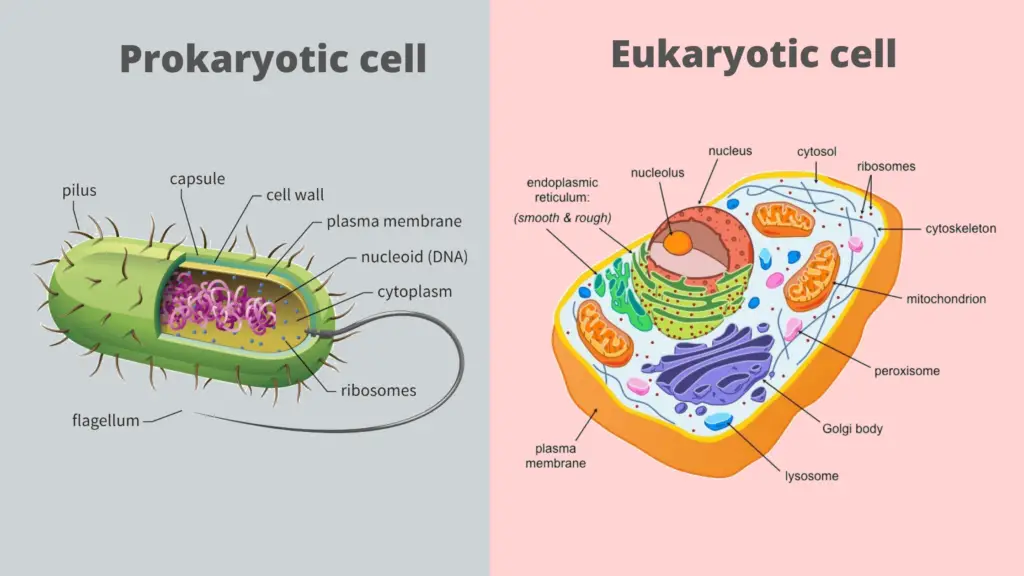
A. Definition of Prokaryotic Cell
The Prokaryotic cells lack a true nucleus or membrane-bound organelles are called Prokaryotic Cells. These are single-celled organisms. All the Bacteria and Archaea are referred to as the prokaryotic cell.
The term Prokaryotic is the combination of two words such as pro and kary. Whereas, Pro means before and kary means the nucleus.
Characteristics of Prokaryotic Cells
- Prokaryotic Cells are unicellular and are the earliest and most primitive forms of life on earth.
- They lack the true nucleus, the DNA is coiled up in a region of the cytoplasm which is called the nucleoid.
- There are present different shapes of prokaryotic cells such as spherical, rod-shaped, and spiral.
- They lack membrane-bounded organelles.
- These are simple cells as compared to eukaryotic cells.
- Prokaryotic has only a single membrane.
- In Prokaryotic cells, all the reactions occur in the cytoplasm.
- They reproduced by the binary fission.
- Some prokaryotic cells are extremophiles means they can thrive in extreme environments such as hydrothermal vents, hot springs, swamps, wetlands, etc.
- The length of a prokaryotic cell is between 0.1 to 5 micrometers.
- These cells have a higher surface-area-to-volume ratio because they are smaller.
Structure of Prokaryotic Cell
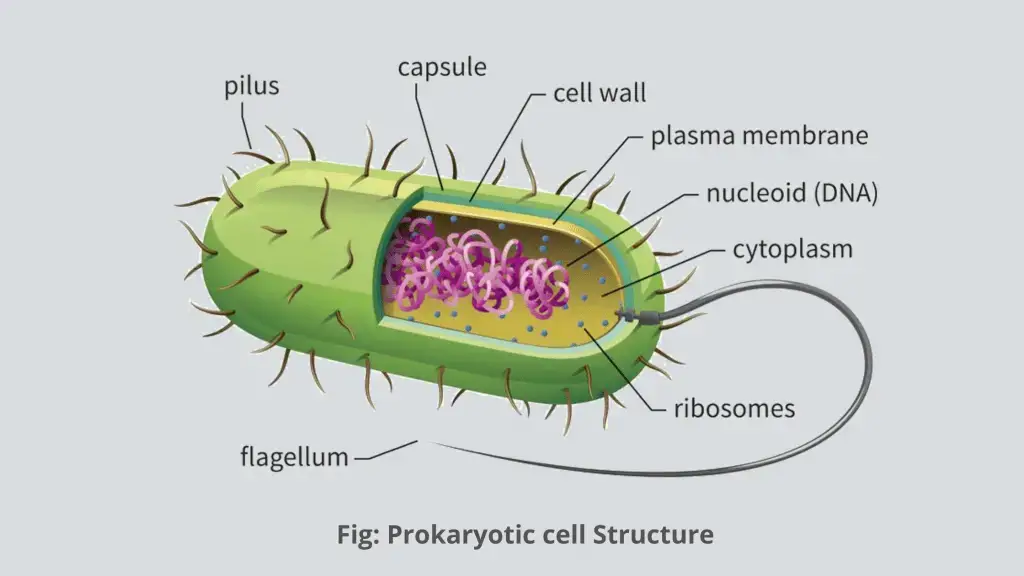
- Capsule
- The capsule is an extra layer that is present in some bacterial cells.
- It is composed of polysaccharides.
- This layer is protecting the cell from foreign invaders.
- It also helps the cell to adhere to a surface or with the nutrients.
- Capsule assists in retaining moisture.
- The Cell wall
- The cell wall surrounded the cytoplasm and provided the cell a distinct shape and rigidity.
- It is located inside the capsule.
- The cell has a relatively high osmotic pressure due the presence of dissolved solutes in high concentration. The cell wall prevents osmotic lysis (bursting due to increasing volume).
- It has peptidoglycan which is composed of polysaccharide chains and they are cross-linked by unusual peptides containing both L- and D-amino acids, such as D-glutamic acid and D-alanine.
- The archaeal cell wall contains pseudopeptidoglycan instead of peptidoglycan. This pseudopeptidoglycan is made up of proteins and other polymers.
- The plasma membrane or cell membrane
- It is a thin phospholipid bilayer and composed of two layers of lipid molecules which separate the cell components from the outside.
- The plasma membrane is about 6 to 8 nanometers thick.
- It is located beneath the cell wall.
- It regulates the flow of substances in and out of the cell.
- Cytoplasm
- The cytoplasm is a gel-like structure surrounded by cell membranes.
- It contains water, enzymes, salts, cell components, and various organic molecules.
- Flagellum
- Some prokaryotic cells contain flagella, it is a long, whip-like protrusion which emerges from the cell surface.
- It helps in locomotions of bacterial cell.
- These are made up of a specific protein called protein flagellin.
- Fimbriae and Pilli
- Fimbriae are the thin and filamentous structures which help to stick the cells on various surfaces.
- Pilli is a hair-like appendage, composed of an oligomeric protein called pilin. These are found in many bacterial and archaeal cell surfaces. During conjugation, the sex pilli holds two cells together as they transfer the DNA molecules.
- Nucleoid region
- It is a space within eukaryotic cell cytoplasm that contains genetic information such as a single circular chromosome and small rings of extrachromosomal DNA called plasmids.
- It is made up of multiple compacted copies of DNA in a continuous thread, with the addition of some RNA and proteins.
- They don’t have any specific size or shape and they can be identified under a light microscope.
- It controls the cell activity and reproduction.
- Ribosomes
- They have a 70S ribosome, which is composed of 30S, and 50S subunits.
- The 50s composed of 23S, and 5S rRNA whereas the 30s is composed of 16S rRNA.
- Their shape and size vary on different prokaryotic cells.
- It helps in protein synthesis.
9. Glycocalyx
- Glycocalyx play an important role as a receptor, it also protects the cell wall.
10. Mesosomes
- Mesosomes are the extension of the plasma membrane, which is unfolded into the cytoplasm. It help in cellular respiration.
11. Inclusion/Granules
- Carbohydrates, glycogen, phosphate, fats are stored in these Inclusion/Granules in the form of particles for later uses.
12. Endospore
- During harsh conditions, it helps the cell to survive.
Reproduction of Prokaryotic cells
Prokaryotic cells are reproduced by asexualy, there are present several methods of asexual reproduction whcih are used by the prokaryotic cells such as;
Binary Fission
Prokaryotes are reproduced by binary fission, in this method the genetic material is replicated and the original cell is divided into two identical cells. In this method no genetic variation occurs within the organism.
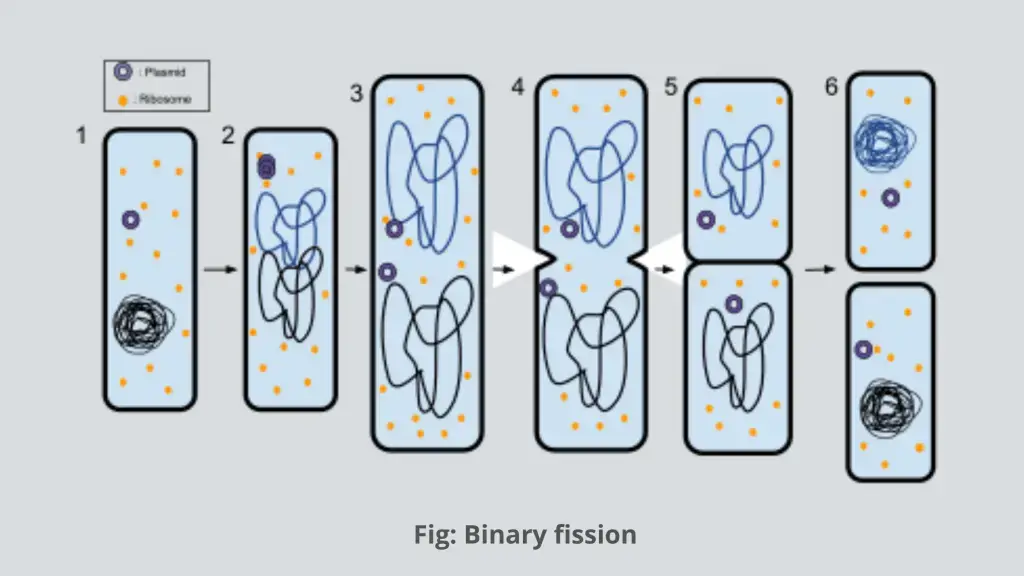
The binary fission is completed by these following steps;
- First of all the DNA is started to divide and produce two identical copies.
- Then both DNA strands move towards the cell membrane.
- After that, the cell membrane started to grow between the two DNA molecules. Once the bacterial cell just about doubles its original size, the cell membrane begins to pinch inward.
- Next, a new cell wall is formed between these two DNA molecules and then it cleaves the parent cell into two identical daughter cells.
Prokaryotic Recombination
The recombination is responsible for the Genetic variation within the bacterial cell. In this method, the genetic material is transferred from the donor cell to the recipient cell and incorporated into the genome.
In bacterial cells the recombination is accomplished by conjugation, transformation, or transduction.
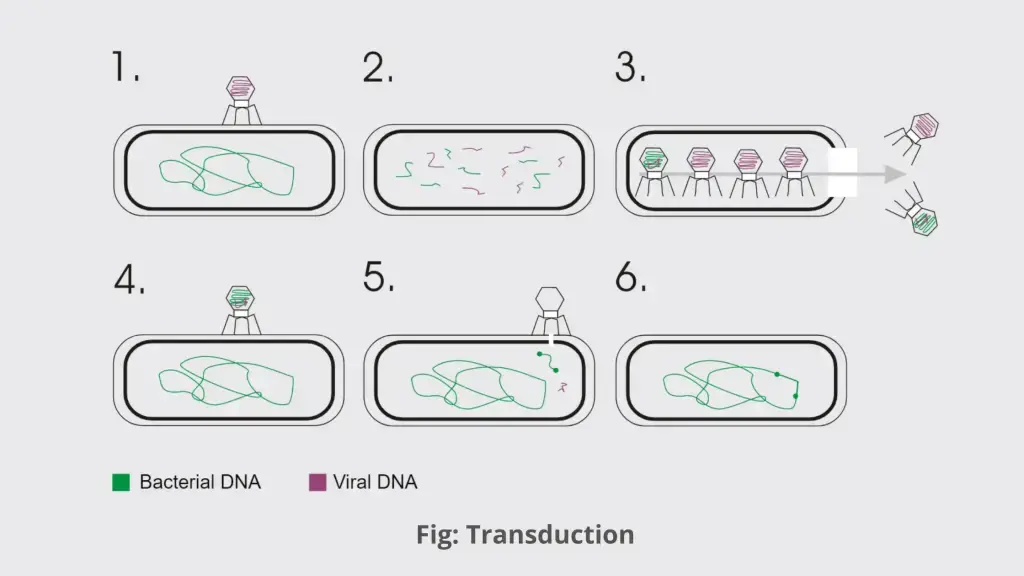
- Conjugation: In this method, sex pill formed a conjugation tube or bridge between the donor cell and recipient cell. Then a genetic material is transferred from donor to recipient through this conjugation tube.
- Transformation: In this method the DNA is transferred into the bacterial cell from its surrounding environment through the cell membrane and then started to incorporate into the bacterial cell’s DNA.
- Transduction: In this method the genetic material is transferred from donor to recipient through the bacteriophage. When bacteria infect any bacterial cell it injects the DNA from the previous bacterial cell.
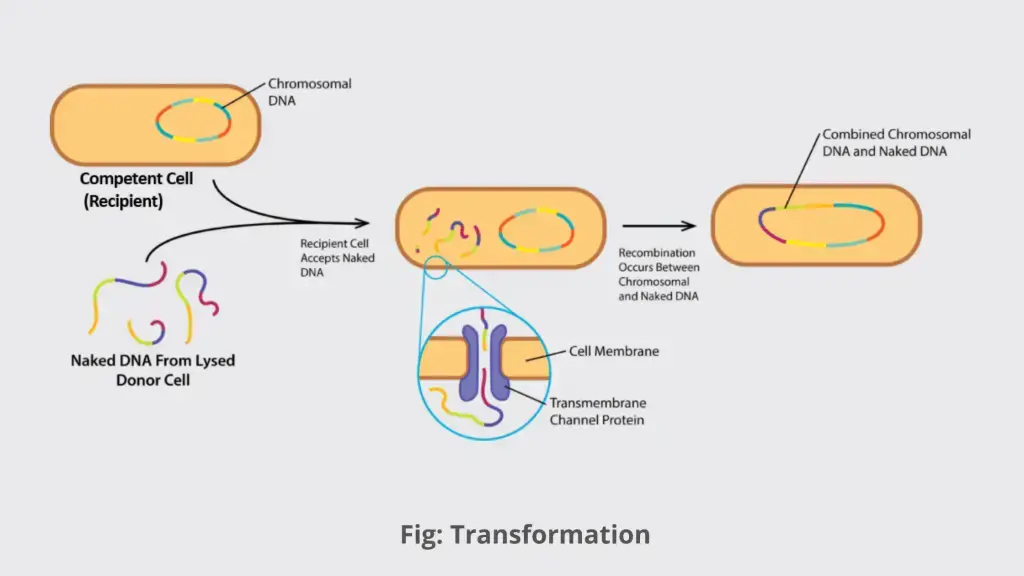
Energy and nutrients for Prokaryotic Cells
- Energy Source
Prokaryotic Cells may be phototrophs or Chemotrophs. The phototrophs will obtain their energy from light and the Chemotrophs will obtain their energy from chemical compounds.
- Carbon Source
Prokaryotes obtain their carbon from different sources for example Autotrophic prokaryotes obtain their carbon from carbon dioxide whereas heterotrophic prokaryotes obtain carbon from organic compounds.
- Microelements
Prokaryotes require metallic elements in small amounts for different activities which are called micronutrients or trace elements. For example iron is required for the function of the cytochromes involved in electron-transport reactions.
- Macronutrients
There are present several molecules such as potassium (K), magnesium (Mg), calcium (Ca), and sodium (Na) which are required in large amounts for the structure and function of the prokaryotic cells are referred as Macronutrients.
Prokaryotic organisms can live in every type of environment on Earth from very hot, to very cold, to super haline, to very acidic. For example they can be alive on boiling springs to permanently frozen environments in Antarctica; from salty environments like the Dead Sea to environments under tremendous pressure, such as the depths of the ocean; and from areas without oxygen, such as a waste management plant, to radioactively-contaminated regions, such as Chernobyl.
Example of Prokaryotic Cell
- Bacteria
- Bacteria are single celled; found everywhere; and appear in different shapes and structures.
- Archaeal Cells
- They are Archaeal Cells and similar to bacterial cells in size and shape.
- They can survive in extreme environments such as hot springs.
B. Definition of Eukaryotic Cell
Eukaryotic cells have a well defined nucleus, membrane bounded organelles and surrounded by plasma membrane. The protozoa, fungi, plants and animals come under Eukaryotic Cell.
The term Eukaryotic comes from Greek word eu, means “well” or “good” and karyon, means “nut” or “kernel”.
Characteristics of Eukaryotic Cell
- Eukaryotic cells are complex as compared to prokaryotic cells.
- The nucleus in eukaryotic cell contains a nuclear membrane which protects the genetic material DNA.
- It has membrane-bounded organelles such as mitochondria and Golgi apparatus, and chloroplasts, etc.
- They reproduced by asexually through mitosis and sexually through meiosis and gamete fusion.
- Eukaryotic cells are larger than the prokaryotic cell and have a diameter about 10-100 µm.
- The shape and size of this cell varies based on the types of organism.
- Some of them contain cell walls which are made up of cellulose or other carbohydrates.
Structure of Eukaryotic Cell
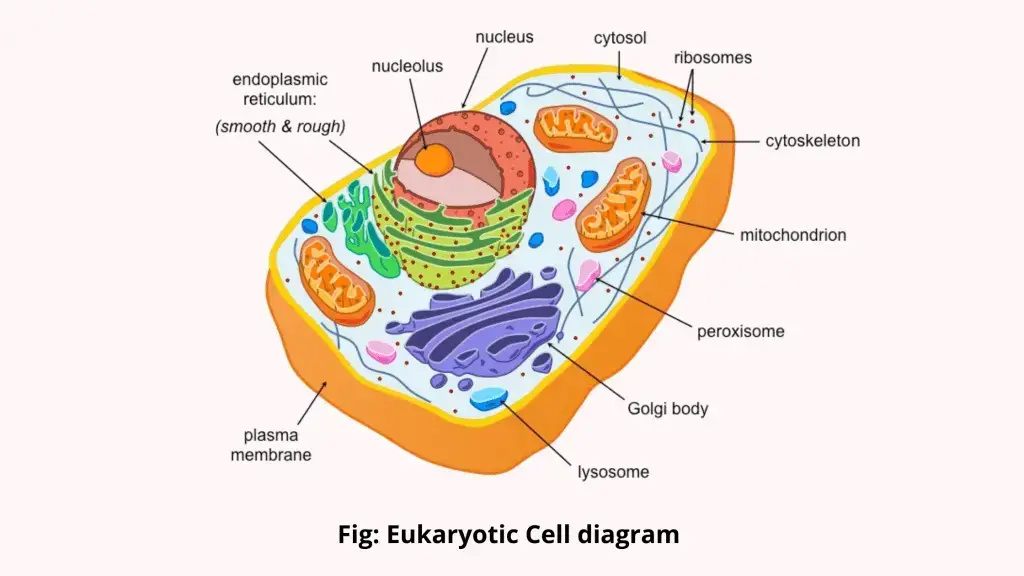
- Cell Wall
- Some prokaryotic cells contain cell walls such as protists, fungal and plant cells.
- In plants and some protists the eukaryotic cell wall is composed of cellulose microfibrils and a network of glycans embedded in the matrix of pectin polysaccharides.
- In fungi the cell wall is composed of polysaccharide, chitin.
- The cell wall provides support and shape to the cell.
- Cell membrane
- It is located beneath the cell wall and composed of phospholipid bilayer with integral proteins which are embedded between the two layers.
- Cytoplasm
- It is a gel like structure surrounded by the cell membrane.
- The cytoplasm contains water,minerals, ions and other cell organelles such as nucleus, mitochondria, ribosome, etc.
- Eukaryotic cells have a higher amount of cytoplasm as compared to prokaryotic.
- Cytoskeletal
- Cytoskeletal is present in cytoplasm; it is a dynamic network of interlinking protein filaments; provides shape and support to the cell.
- The eukaryotic cytoskeleton is composed of three components such as microfilaments, intermediate filaments and microtubules.
- Cell Organelles
- Nucleus: The eukaryotic nucleus is well defined, has a nuclear membrane and nucleolus. The genome within the nucleus is coupled with various proteins like the histone protein. Nucleus is also called the “brain” of cell because it controls different activities.
- Mitochondria: It produces energy in the form of ATP.
- Ribosomes: It produces protein in the cell.
- Golgi Apparatus: it processes and packages the proteins.
- Lysosome: It contains enzymes which help in breakdown of larger macromolecules.
- Endoplasmic Reticulum: It helps in transport of all sorts of items around the cell.
- Vacuole: It is the storage house of a cell, vacuole stores water or food.
- Chloroplasts: contains photosynthetic pigments which helps in photosynthesis of plant cells.
Reproduction of Eukaryotic Cells
Most of the eukaryotic cells follow the sexual reproduction and rest of the eukaryotes follow the asexual reproduction.
Sexual Reproduction
- Plants and animal cells follow sexual reproduction. In this method the parent cell is divided into four daughter cells and each of these cells contains half the number of chromosomes to their parent cell. The variations in eukaryotic cells occur due to this sexual reproduction.
Asexual Reproduction
- Mitosis is the most common method of asexual reproduction, in this methos the parent cell is enlarged in size and divided into two identical daughter cells. In this mode of reproduction no variations occur in eukaryotic cells.
- Protist and fungal cells follow the budding process for their reproduction. In this method a bud or outer growth occurs on the cell surface and then it separates from the parent cell and forms a fully grown daughter cell.
- Binary fission and multiple fission also occur in cells of primitive eukaryotes.
- There are several fungi who follow the sporulation method for reproduction.
Different types of Eukaryotic Cell
- Plant Cells:
- Plant cell wall is thick as compared to other eukaryotic cells and contains cellulose, hemicellulose and pectin.
- They contain a large vacuole, which is enclosed by a membrane, the tonoplast. The vacuole controls the cell’s turgor and movement of molecules within the cytosol and sap.
- They contain plasmodesmata which connect the two adjacent cells.
- They contain chloroplast which helps them in photosynthesis. The chloroplast contains chlorophyll pigments which help them in photosynthesis.
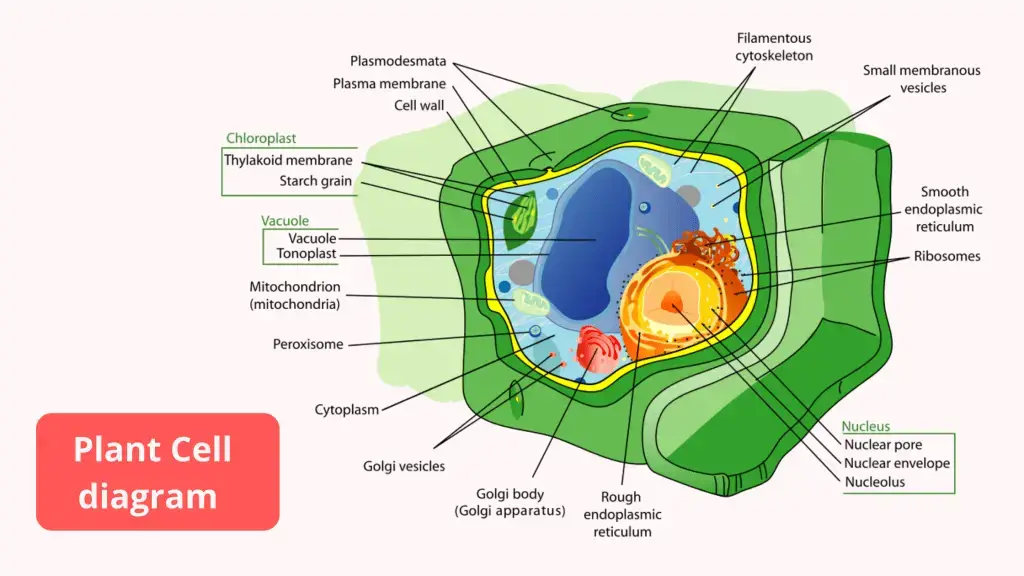
- Fungal Cells:
- The cell wall of a fungal cell is made up of chitin.
- Some fungal cells contain holes which allow organelles and cytoplasm to pass between them, these holes are called septa.
- Only chytrids contain flagella.
- Animal Cells:
- The animal cells lack the cell wall instead of they contain plasma membrane.
- They performed phagocytosis “cell eating” and pinocytosis “cell drinking” processes within the cell.
- These are different from plant cells because they lack chloroplasts and have smaller vacuoles.
- Instead of plasmodesmata they contain a different analogous system of gap junctions between adjacent cells.
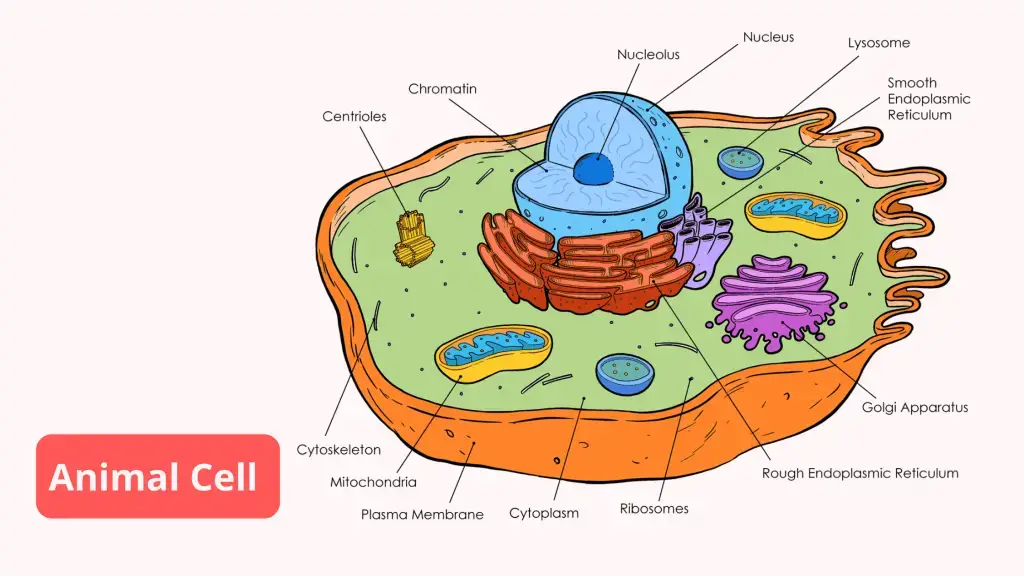
- Protozoa:
- Protozoa are single-celled and digest their food in vacuoles. They contain cilia which looks like small arms, it helps them in locomotion.
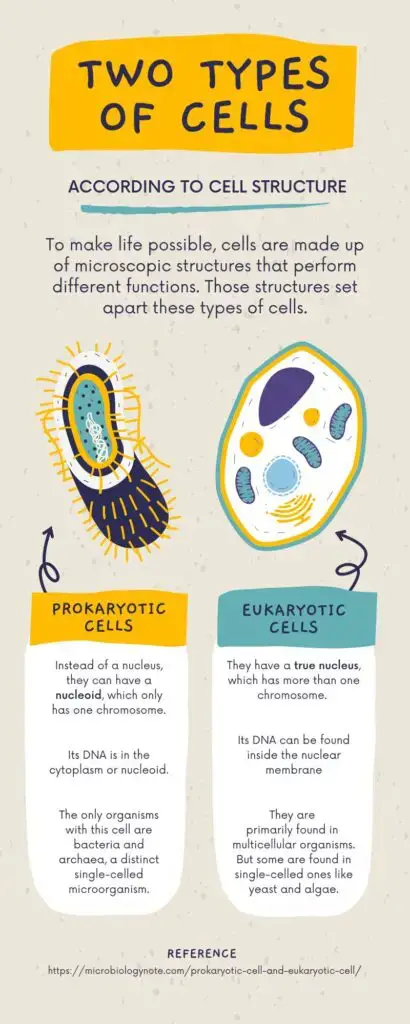
References
- https://biologydictionary.net/prokaryotic-cell/#prokaryotic-cell-parts
- https://www.thoughtco.com/prokaryotes-meaning-373369
- https://en.wikipedia.org/wiki/Prokaryote
- https://www.khanacademy.org/science/high-school-biology/hs-cells/hs-prokaryotes-and-eukaryotes/a/prokaryotic-cells
- https://bio.libretexts.org/Bookshelves/Introductory_and_General_Biology
- https://www.windows2universe.org/earth/Life/cell_organelles.html
- https://biologydictionary.net/eukaryotic-cell/
- https://www.britannica.com/science/eukaryote
- https://www.khanacademy.org/science/high-school-biology/hs-cells/hs-prokaryotes-and-eukaryotes/a/intro-to-eukaryotic-cells
- https://en.wikipedia.org/wiki/Eukaryote#Classification
- https://biodifferences.com/difference-between-prokaryotic-cells-and-eukaryotic-cells.html
- Text Highlighting: Select any text in the post content to highlight it
- Text Annotation: Select text and add comments with annotations
- Comment Management: Edit or delete your own comments
- Highlight Management: Remove your own highlights
How to use: Simply select any text in the post content above, and you'll see annotation options. Login here or create an account to get started.